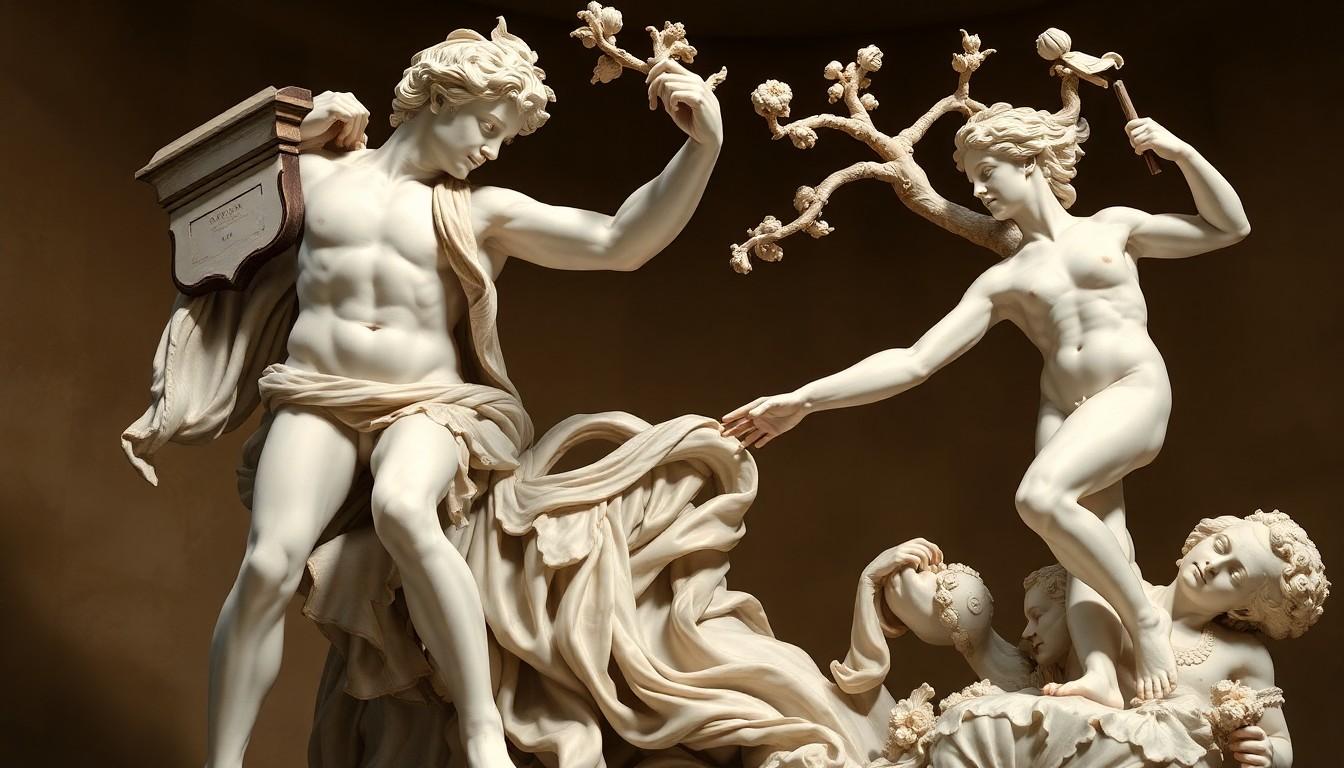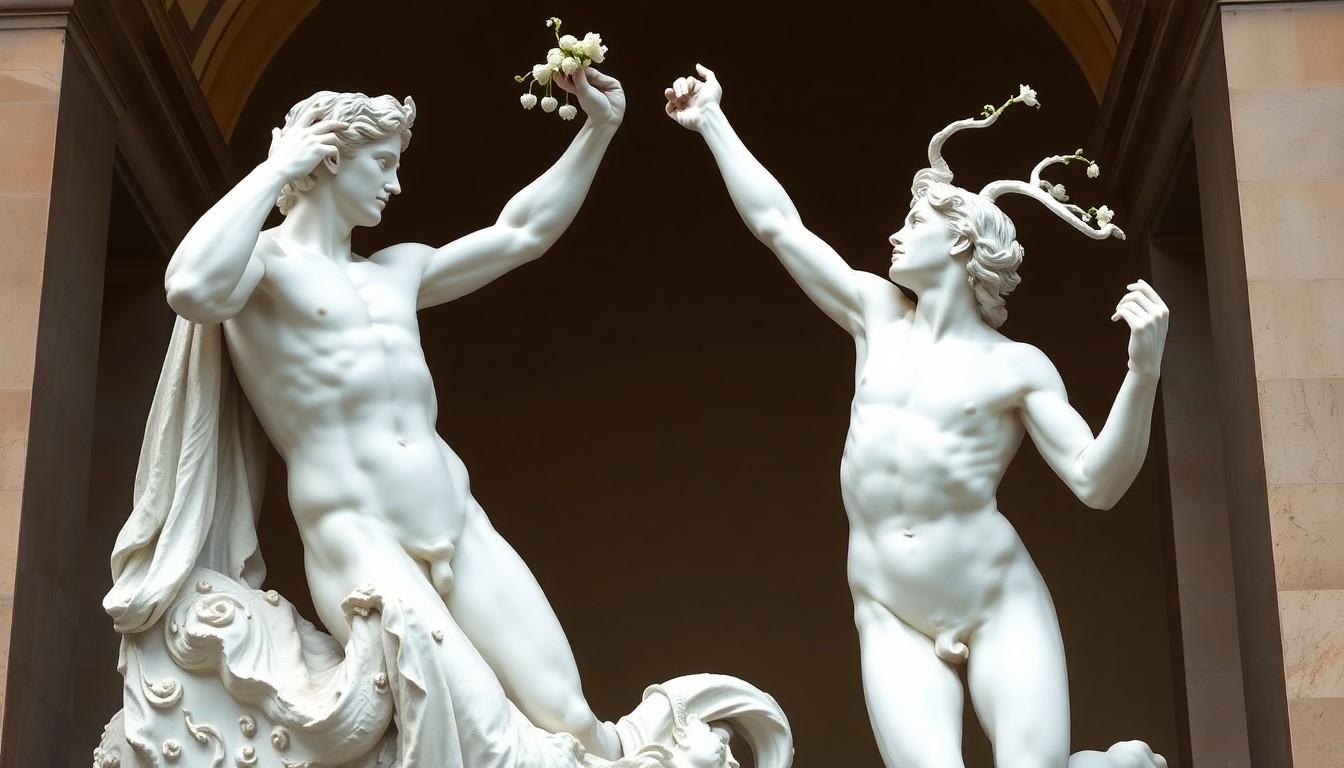In the world of classical art, few stories capture the imagination quite like that of Apollo and Daphne. This iconic sculpture, masterfully crafted by Gian Lorenzo Bernini, immortalizes a dramatic moment from Greek mythology where love and transformation collide. Imagine Apollo, the god of the sun, chasing after the beautiful nymph Daphne, who’s not exactly thrilled about his advances. Spoiler alert: things get a bit sticky as she turns into a laurel tree to escape his relentless pursuit.
Apollo and Daphne Sculpture
Gian Lorenzo Bernini created the Apollo and Daphne sculpture between 1620 and 1625. This masterpiece showcases dynamic movement and intricate details, capturing a pivotal moment from Greek mythology. Apollo, depicted in a powerful stance, reaches for Daphne, who transforms into a laurel tree. The artist skillfully conveys emotion through facial expressions and body language.
The sculpture measures approximately 243 cm in height, 160 cm in length, and 130 cm in depth, emphasizing the grandeur of the scene. Located in the Galleria Borghese in Rome, it attracts visitors seeking to witness Bernini’s artistry firsthand. Critics often praise the work for its technical proficiency and narrative depth.
Crafted from white Carrara marble, the sculpture’s smooth texture contrasts with the complexity of the figures. Leaves sprouting from Daphne’s fingertips illustrate her transformation, symbolizing both escape and the birth of laurel as a sacred plant. This element enhances the story’s emotion, portraying the struggle between desire and divinity.
Bernini’s Apollo and Daphne sculpture exemplifies Baroque art’s focus on movement and realism. The work stands as a testament to the artist’s mastery of capturing human experience. Known for its theatricality, the piece embodies the tension between the two characters, creating an engaging visual narrative. Art historians often cite this sculpture as a defining example of Bernini’s influence on the art world.
Rich in symbolism and artistry, Apollo and Daphne resonates with themes of love, pursuit, and transformation. The piece remains a crucial part of classical art discussions, reflecting Bernini’s significance in Baroque sculpture.
Historical Context

The sculpture of Apollo and Daphne holds significant historical importance within the realm of classical art. Its creation reflects various cultural and artistic movements during the early 17th century.
Origin and Commission
Gian Lorenzo Bernini received the commission for Apollo and Daphne from Cardinal Scipione Borghese around 1620. The cardinal sought to showcase the power of art in expressing human emotion and drama. Bernini, known for his mastery in marble, seized the opportunity to create a piece reflecting both movement and narrative depth. A detailed interpretation of the mythological story became central to the sculpture’s design. Art patrons and collectors admired the work for its technical skill and emotional resonance, making it a key piece in Cardinal Borghese’s collection.
Artistic Movement
Apollo and Daphne epitomizes the Baroque artistic movement that emerged in Europe during the 17th century. Characteristics of this movement include emotional intensity, dramatic contrasts, and dynamic compositions. In Bernini’s work, fluidity and realism stand out, drawing the viewer into the narrative. Sculptors like Bernini pushed boundaries, blending different styles to reflect the tension inherent in the story’s themes of love and transformation. His innovative techniques created lifelike figures and intricate details, setting a high standard for future sculptures in the Baroque tradition.
Analysis of the Sculpture
The sculpture of Apollo and Daphne reveals both masterful craftsmanship and rich thematic content.
Materials and Techniques
Bernini used white Carrara marble to craft this sculpture. Its smooth texture enhances the dynamic forms of Apollo and Daphne. Remarkably, the artist showcased intricate details, from the flowing hair of the figures to the delicate leaves sprouting from Daphne’s fingers. He employed chiseling methods that highlighted movement and realism. Skillfully, Bernini captured the tension of the moment, making it feel alive. His innovative approach set new benchmarks for Baroque art, ultimately influencing generations of sculptors.
Symbolism and Themes
Symbolism appears throughout Apollo and Daphne, emphasizing critical themes. The transformation of Daphne into a laurel tree represents the struggle between desire and self-preservation. Laurel leaves symbolize triumph and immortality, reflecting Daphne’s evasion of Apollo’s pursuit. The tension between the divine and the mortal is palpable, offering a narrative depth that engages viewers. Furthermore, the figures’ intertwined poses illustrate the complexities of love, highlighting both longing and desperation. This artwork encapsulates the emotional intensity typical of Baroque art, reinforcing its significance within the historical context.
The Artists Behind the Work
Gian Lorenzo Bernini stands as a pivotal figure in Baroque sculpture. Born in 1598 in Naples, his artistic prowess flourished in Rome, shaping the landscape of Italian art. Known for his ability to convey emotion and movement, Bernini crafted Apollo and Daphne between 1620 and 1625, capturing a moment of dramatic transformation. His meticulous attention to detail and innovative techniques in marble carving allowed him to create lifelike figures that evoke a strong narrative.
Gian Lorenzo Bernini
Bernini’s career began early, with significant works marking his rise to prominence. His talents caught the eye of influential patrons, including Cardinal Scipione Borghese, who commissioned Apollo and Daphne. This work exemplifies Bernini’s mastery, showcasing both technical skill and a deep understanding of mythological themes. The artist’s ability to breathe life into stone is evident in the dynamic poses and expressions of Apollo and Daphne, creating a vivid representation of desire and evasion.
Influence and Legacy
Following the completion of Apollo and Daphne, Bernini’s contributions significantly influenced the Baroque movement. His integration of emotion and realism redefined sculpture, inspiring numerous artists throughout Europe. Many followed in his footsteps, emulating his techniques and narrative depth. Over time, Bernini’s work laid a foundation for future generations, impacting not only sculpture but also architecture and painting. Apollo and Daphne remains a crucial example of his legacy, with its inherent themes continuing to resonate in the art world today.
Reception and Impact
Reception of Bernini’s Apollo and Daphne has been overwhelmingly positive, establishing its place in art history. Critics marvel at the sculpture’s ability to convey deep emotion and movement through marble. Many viewers associate the figures with themes of desire and transformation, resonating strongly with audiences since the early 17th century.
Impact on Baroque art remains significant. This masterpiece set a standard for technical proficiency, influencing subsequent generations of sculptors. Artists such as Francesco Borromini and Antonio Canova drew inspiration from Bernini’s dynamic forms and emotional expression.
Exhibitions featuring Apollo and Daphne contribute to its sustained relevance. Museums worldwide showcase this work, highlighting Bernini’s innovative techniques and rich narrative. Popularity remains robust, drawing thousands of visitors to the Galleria Borghese, where the sculpture resides.
Studies on Apollo and Daphne enhance understanding of its cultural context. Scholars explore links between the sculpture and themes in contemporary literature and visual arts. Discussions around the piece often highlight the balance of desire and self-preservation, reflecting broader societal themes relevant to both past and present.
Recognition of Bernini extends beyond this single work. Contributions to the Baroque movement establish him as a pivotal figure in artistic history. Continued analysis of Apollo and Daphne serves to reinforce its status as a defining example of Baroque sculpture. The work continues to captivate audiences, symbolizing the interplay between myth and artistic expression.
The Apollo and Daphne sculpture by Gian Lorenzo Bernini stands as a monumental achievement in Baroque art. Its intricate details and dynamic forms capture a moment of profound emotional intensity, illustrating the timeless themes of love and transformation. This masterpiece not only showcases Bernini’s exceptional skill in marble carving but also reflects the broader cultural and artistic movements of the early 17th century.
As a pivotal work in art history, Apollo and Daphne continues to inspire and engage audiences, drawing attention to the complexities of desire and the human experience. Its lasting impact on the art world solidifies Bernini’s legacy as a master sculptor whose work remains relevant and celebrated today.

